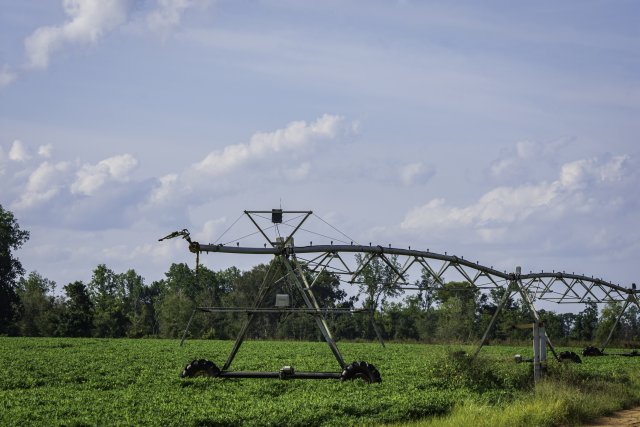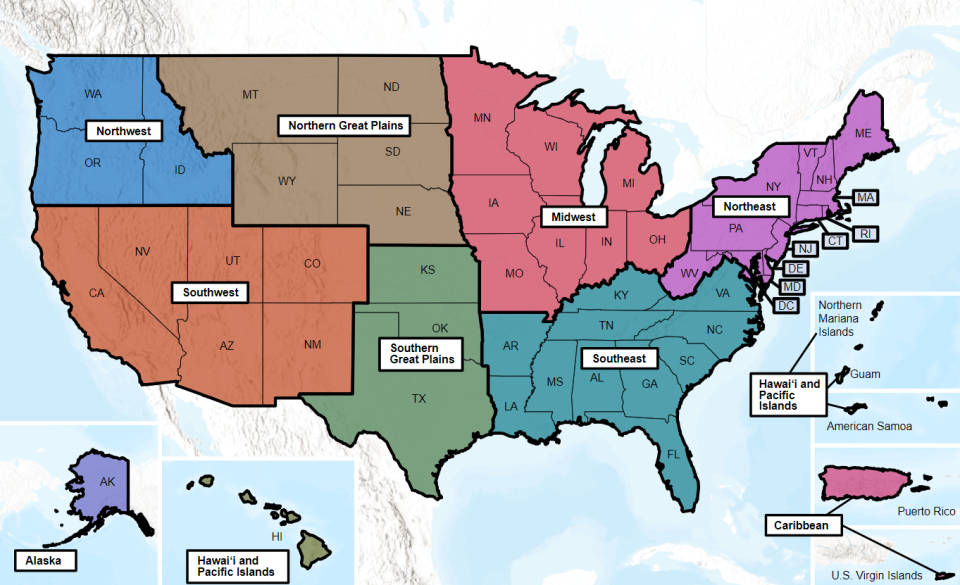Climate Change Connections: Alabama (Peanuts)
Climate change is impacting all regions and sectors of the United States. The State and Regional Climate Change Connections resource highlights climate change connections to culturally, ecologically, or economically important features of each state and territory. The content on this page provides an illustrative example. As climate change will affect each state and territory in diverse ways, this resource only describes a small portion of these risks. For more comprehensive information about regional climate impacts, please visit the Fifth National Climate Assessment and Climate Change Impacts by Sector.
On this page:
Introduction: Agricultural and Historical Significance of Peanuts in Alabama
Peanuts have been a major crop in southern Alabama since the early 1900s, and are an important part of the state’s economy and heritage. Today, Alabama ranks second in the United States for peanut production behind Georgia.1 Southern Alabama is well suited for growing peanuts due to its warm climate and well-drained, sandy soils.2,3 Alabama’s peanut industry supports thousands of jobs and annually generates tens of millions of dollars for the state economy.4

Peanuts were likely brought to North America from Africa by enslaved people in the 1700s. In the late 19th century, the peanut began to take off as a widespread agricultural product in the American South due to a variety of factors including advances in technology that made harvesting and processing easier.5 The expansion of peanuts in the South can also be credited in part to efforts by agricultural scientist George Washington Carver. During a long career, much of it at the Tuskegee Institute, Carver discovered over 300 uses for peanuts and contributed to numerous agricultural advances, particularly to address soil depletion.6
Due to their agricultural success, peanuts are a source of pride for many of Alabama’s peanut farming communities. To celebrate peanut farmers and their harvests, the City of Dothan, Alabama, holds the 10-day National Peanut Festival each fall, attracting 200,000 visitors every year.3 The first festival was held in 1938, and the City of Dothan has been known as the “Peanut Capital of the World” ever since. Boiled peanuts, a favorite snack in Alabama, are often sold at roadside stands throughout the state. Alabama designated the peanut as the official state legume in 2022.7
Climate Impacts: Higher Temperatures Could Decrease Peanut Yields

As the concentrations of heat-trapping greenhouse gases in the atmosphere continue to increase, the United States has experienced warming temperatures. Alabama is one of the few areas in the United States that has not experienced considerable warming since the beginning of the 20th century.8 However, the warmest consecutive five-year interval on record was the most recent, from 2016 to 2020, and temperatures in Alabama are expected to rise further over this century.9
Like many crops, peanuts can be affected by high temperatures.10 Peanuts grow best with moderately warm temperatures and sufficient rainfall during their growing season in Alabama, which typically falls between April and October.11 Higher temperatures during the peanut growing season can result in lower yields.10 Peanut plants develop faster under warmer conditions, which leads to fewer pods and smaller seeds, resulting in less fruitful peanut harvests.2
Drought Could Place Further Strain on Peanuts
As average temperatures rise because of climate change, the dynamics of Earth’s water cycle are changing due to increased rates of evaporation from the Earth’s surface and transpiration from plants. This increase in evapotranspiration makes more water available in the air for precipitation, but contributes to drying over some land areas, leaving less moisture in the soil. While there is uncertainty about future precipitation changes in Alabama, the combination of higher temperatures and well-drained soils can create conditions for flash droughts.9 A flash drought is a rapid onset of dry conditions fueled by high temperatures and lack of precipitation. While sandy soils are ideal for growing peanuts, their excellent drainage makes them more vulnerable to drought when evaporation rates increase.

In September 2019, a flash drought caused peanut farmers in the Alabama Wiregrass region to lose an estimated 10 percent to 20 percent of their peanut crop.12,13 As a result of the drought, the peanuts harvested were reported to be smaller, and the hard, dry ground made harvesting the peanuts more difficult.13 Impacts on agriculture, such as drought, can disproportionately affect small-scale and economically disadvantaged farmers, who have fewer resources to adapt and respond to a changing climate.14
Heat- and drought-stressed peanut crops can also be more susceptible to a type of fungus that produces toxins harmful to humans. Warmer temperatures can promote increased growth of the fungus,15 and drought-stressed peanut pods can develop cracks that allow the fungus to penetrate the legume.16 Peanuts with high levels of contamination cannot be sold for consumption in the United States.17
Taking Action: Fostering Resilient Peanut Growing in a Warmer, Drier Climate
Addressing climate change requires reducing greenhouse gas emissions while preparing for and protecting against current and future climate impacts. Communities, public officials, and individuals in every part of the United States can continue to explore and implement climate adaptation and mitigation measures. In Alabama, researchers and farmers are exploring opportunities to promote resilience of peanuts in a changing climate, including:
- Drought-tolerant peanuts. Scientists at Auburn University are researching the development of new drought-tolerant peanut varieties.18 Planting hardier varieties of peanuts that require less water could help improve their resilience to droughts and increase peanut yields without placing additional strain on water supplies.
- Water management techniques. By using a technique called regulated deficit irrigation early in the growing season, farmers can intentionally limit watering their crops at certain growth stages.19 This technique allows peanut plants to adapt to having less water, and could enable them to better tolerate mid- and late-season droughts.19 This technique allows peanuts to maintain their yields after being exposed to induced early-season drought,20 and also reduces strain on water resources.19
To learn more about climate change impacts in Alabama and the Southeast United States, see Chapter 22 of the Fifth National Climate Assessment.
Related Resources
- Climate Change Impacts on Agriculture and Food Supply (EPA)
- Fifth National Climate Assessment: Chapter 11: Agriculture, Food Systems, and Rural Communities (U.S. Global Change Research Program)
- Alabama’s Priority Climate Action Plan (Alabama Department of Environmental Management) (pdf) (11 MB)
- Alabama State Climate Summary 2022 (NOAA)
References
1 U.S. Department of Agriculture. (2023, March 29). Georgia leads U.S. production of peanuts, outproducing all other states combined. Economic Research Service. Retrieved November 10, 2023, from http://www.ers.usda.gov/data-products/chart-gallery/gallery/chart-detail/?chartId=106192
2 Zhen, X., Huo, W., Tian, D., Zhang, Q., Sanz-Saez, A., Chen, C. Y., & Batchelor, W. D. (2023). County level calibration strategy to evaluate peanut irrigation water use under different climate change scenarios. European Journal of Agronomy, 143, 126693. https://doi.org/10.1016/j.eja.2022.126693
3 Dixon, R. (2023, March 30). Peanut production in Alabama. Encyclopedia of Alabama. Retrieved September 6, 2023, from https://encyclopediaofalabama.org/article/peanut-production-in-alabama/
4 Fields, D., Guo, Z., Hodges, A. W., & Rahmani, M. (2013). Economic impacts of Alabama’s agricultural, forestry, and related industries. Alabama Cooperative Extension System. https://www.forestry.alabama.gov/Pages/Management/Forms/Economic_Impact.pdf (pdf) (3 MB)
5 Hauser, A. (2018). Peanuts. Journal of Agricultural & Food Information, 19(3), 195–202. https://doi.org/10.1080/10496505.2018.1483677
6 National Park Service. (2023). George Washington Carver. Retrieved July 29, 2024, from https://www.nps.gov/people/george-washington-carver.htm
7 Ala. Code § 1-2-44, no. HB350, Senate (2022).
8 EPA. (2024). Climate change indicators: U.S. and global temperature. Retrieved June 18, 2024, from https://www.epa.gov/climate-indicators/climate-change-indicators-us-and-global-temperature
9 Runkle, J., Kunkel, K. E., Stevens, L. E., Frankson, R., & Rayne, S. (2022). Alabama state climate summary 2022 (NOAA Technical Report NESDIS 150-AL). NOAA National Environmental Satellite, Data, and Information Service. https://statesummaries.ncics.org/chapter/al/
10 Eck, M. A., Murray, A. R., Ward, A. R., & Konrad, C. E. (2020). Influence of growing season temperature and precipitation anomalies on crop yield in the southeastern United States. Agricultural and Forest Meteorology, 291, 108053. https://doi.org/10.1016/j.agrformet.2020.108053
11 U.S. Department of Agriculture. (2010). Field crops usual planting and harvesting dates (Agricultural Handbook Number 628). National Agricultural Statistics Service. https://downloads.usda.library.cornell.edu/usda-esmis/files/vm40xr56k/dv13zw65p/w9505297d/planting-10-29-2010.pdf (pdf) (2 MB)
12 Di Liberto, T. (2019, October 9). Flash drought engulfs the U.S. Southeast in September 2019. NOAA Climate.gov. Retrieved September 7, 2023, from http://www.climate.gov/news-features/event-tracker/flash-drought-engulfs-us-southeast-september-2019
13 National Drought Mitigation Center. (2019, October 14). Peanut crop damaged, partially lost in southeast Alabama. Drought Impact Reporter. Retrieved November 13, 2023, from https://moderator.droughtreporter.unl.edu/RSSfeed/ImpactView/48477
14 Hoffman, J. S., McNulty, S. G., Brown, C., Dello, K. D., Knox, P. N., Lascurain, A., Mickalonis, C., Mitchum, G. T., Rivers III, L., Schaefer, M., Smith, G. P., Camp, J. S., & Wood, K. M. (2023). Ch. 22. Southeast. In Fifth National Climate Assessment. U.S. Global Change Research Program. https://doi.org/10.7930/NCA5.2023.CH22
15 Valencia-Quintana, R., Milić, M., Jakšić, D., Šegvić Klarić, M., Tenorio-Arvide, M. G., Pérez-Flores, G. A., Bonassi, S., & Sánchez-Alarcón, J. (2020). Environment changes, aflatoxins, and health issues, a review. International Journal of Environmental Research and Public Health, 17(21), 7850. https://doi.org/10.3390/ijerph17217850
16 Magan, N., Medina, A., & Aldred, D. (2011). Possible climate-change effects on mycotoxin contamination of food crops pre- and postharvest. Plant Pathology, 60(1), 150–163. https://doi.org/10.1111/j.1365-3059.2010.02412.x
17 U.S. Food and Drug Administration. (2021). Compliance policy guide sec. 570.375 aflatoxins in peanuts and peanut products: Guidance for FDA staff. Center for Food Safety and Applied Nutrition and Office of Regulatory Affairs. https://www.fda.gov/media/72073/download
18 Hollis, P. (2020, August 18). Auburn University peanut breeding program works on drought-tolerant plant. The Newsroom, Auburn University. Retrieved September 5, 2023, from https://ocm.auburn.edu/newsroom/news_articles/2020/08/180820-chen-drought-tolerance.php
19 Rowland, D. L., Faircloth, W. H., Payton, P., Tissue, D. T., Ferrell, J. A., Sorensen, R. B., & Butts, C. L. (2012). Primed acclimation of cultivated peanut (Arachis hypogaea L.) through the use of deficit irrigation timed to crop developmental periods. Agricultural Water Management, 113, 85–95. https://doi.org/10.1016/j.agwat.2012.06.023
20 USDA. (2010, January). Preparing Peanuts for the Future: New Cultivars and Farming Strategies. Agricultural Research Magazine, 58(1). https://agresearchmag.ars.usda.gov/2010/jan/peanuts

